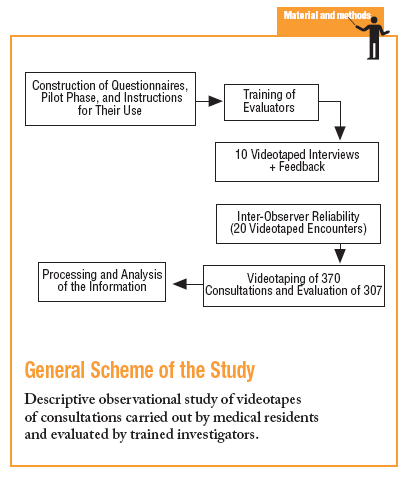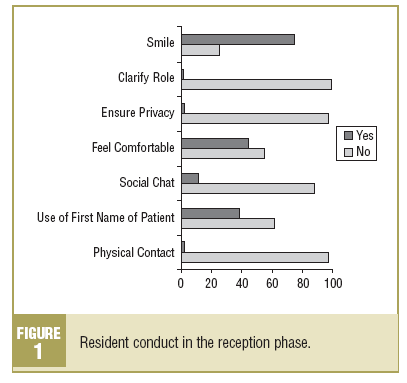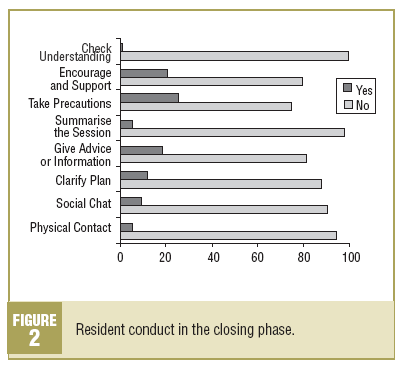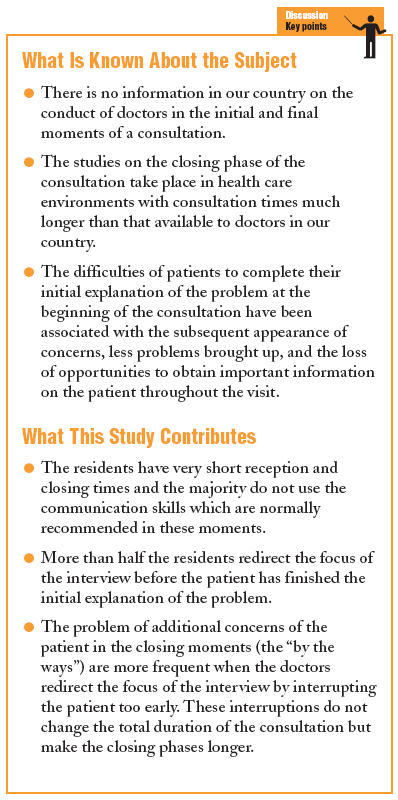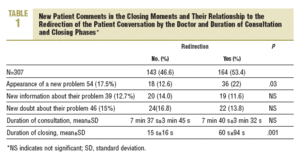Introduction
The clinical consultation as communicative interaction has been the objective of different types of studies. These have helped us understand some of the more significant relational processes in a clinical act and among which stand out is the way in which the professional and the patient interchange information, how it produces motivation and co-responsibility by the patient in the taking of decisions, or in the acceptance of responsibilities, or the different ways in which some of the most common communication conflicts arise and are resolved.1,2
The most frequently used observational strategy for this type of analysis used to be the identification of certain behaviours throughout the complete interview or in particular times during this. However, there are some phases of the consultation where the information is very scarce. Thus, there are very few studies which tackle how the professional and patient behave at the time of entering and leaving the consulting room. This is mainly because these moments are traditionally not considered important for the development of the clinical tasks. It seems that the entering and leaving has more social content, but for precisely for this reason, these moments can be important to establish or strengthen the relationship between the professional and the patient and to receive information of a different nature. There are practically no observational studies on how the start of the consultation develops and the few studies on the ending, carried out in clinical environments very different from ours, have highlighted the importance of these final moments; among other tasks, resume the consultation, check the understanding of or clarify the plans agreed.3,4 We know the importance of the first moments of a consultation for the process of obtaining information.5,6 In our environment, we have no studies available which give information on the conduct of the professionals in these particular moments of the consultation, for this reason the objective of this work has been to characterise the initial moments (reception, first seconds of receiving information) and the end of the consultation, carried out by medical residents and evaluate in what way very early interrupting of the patients by the residents affect some of the intra-consultation results, such as the length of the closing or the appearance of new concerns in this phase.
Patients and Method
The descriptive observational study was carried out in primary care clinics attended by third year residents (R3) in family medicine. The patients came to the clinics for a new clinical problem. The study protocol was approved by the Clinical Research Ethics Committee of the Queen Sofia University Hospital of Cordoba. The residents and the patients were informed of the objectives of the study and their consent was requested. All the interviews were recorded in their entirety.
Based on the medical literature on the subject,1,3,7,8 on our experience as doctors and teachers, and in a pilot study carried out with 15 clinical interviews, we drew up 2 protocols or patient report forms for the analysis of the 3 phases of the consultation studied: 1) the reception (which is identified as the time from when the patient enters until the doctor invites the patient to talk about his/her problem: what is wrong? Or similar: 2) the first moments of taking information; up to the first 2 minutes or until the patient spontaneously stops talking or it passes to another phase of the visit such as a physical examination, the doctor gives information...); and 3) the closing (from the end of any phase of the visit such as obtaining or giving information, to prescribing, to educate, e.g. "Fine...well, then we agree, well Antonio, that's all..." until the patient leaves the consulting room). Later, the 2 observers received specific training using 10 real clinic visits which outlined discrepancies. The inter-observer reliability was measured by means of 20 new interviews and obtaining the kappa coefficients for the qualitative items and the within class correlation coefficients for the quantitative ones. Except for visual contact, the remaining 14 items of the reception had good kappa coefficients. Of the 10 items of the initial information gathering phase 2 were excluded due to low reliability (eye-to-eye contact and encouraging narratives). Of the 17 items in the closing phase, only 2 were excluded owing to having low kappa values.
All the R3 participated in the study (37 R3, 26 males). Three hundred and seventy clinical interviews were completed with patients who agreed to take part and who presented with incidental problems. Finally, 307 of the consultations were of good audiovisual quality. Following Marvel et al,6 we called any intervention carried out by the doctor before the patient finished what he/she was saying on a problem, and which caused this to change the thread of this discourse, a "redirection" (instead of interruption). The total time of the consultation, the closing, and any patient comment on a new problem or new information or doubt on the reason for the consultation during the closing, was recorded.
Descriptive and bivariate descriptive statistical analysis was performed (*2 and the Student t test: P<.05) using the Windows SPSS version 11.0 statistics package.
Results
The R3 had a mean age of 28 years (range, 26-32 years), 70% of whom were males. Of the 307 interviews analysed, 125 (41.5%) patients were accompanied. The mean duration of the consultation was 7 min 39 s (95% confidence interval [CI], 7 min 14 s-8 min 3 s; median, 7 min), with a mean duration of the reception of 17 min 80 s (95% CI, 15 min 72 s19 min 89 s; mean, 11 s) and the closing of 22 min 80 s (95% CI, 17 min 73 s27 min 86 s; median, 10 s).
The conduct performance in the reception phase is shown in Figure 1. It highlights a group of conducts with a very high percentage of non-use (near or higher than 90%): physical contact, social chat, assuring privacy, and clarifying role. Less than 50% of the residents smiled and made the patients comfortable and greeted the patients in practically all the consultations, as a general rule, curtly and verbally.
In 21.3% of the interviews (65 patients) a comment made by the patient at the time of reception, which was different to the main reason for consultation, was recorded. Of these, 16 made reference to their health problems, 9 offered potential information about the professional, 8 on the patient himself and in a socio-familial context, 2 on the
health system, 16 other types of information and 4 were different combinations of the previous options. The resident did not respond to the majority of the comments.
The average time analysed in the first seconds of obtaining information on the reason for the consultation was 1 min 15 s±35 s (median 1 min 10 s). The monologues of the patients, which were completed, lasted an average of 16.77 s±16.76 s. Likewise, in 53.4% of the interviews the resident redirected the initial conversation of the patient. The median time to make this redirection was 16.5 s and its range was 2 s to 1 min 50 s. The most frequent method which the residents used to interrupt and redirect the monologue of the patient was by using closed questions (80%). However, they also interrupted with comments (9%).
In 85% of cases, the closing phase was initiated by the resident. The conduct performance by the doctor in this phase recorded in the case report forms is shown in Figure 2. At the time of closing 7.5% of patients or their companion made social chat, 17.5% brought up a new problem and 12.7 % and 15%, respectively, commented on something new or brought up a new doubt on their problem. The number of consultations where the doctor redirected the initial comment of the patient and its relationship with new comments which were made at the closing and the duration of the consultation and closing, is shown in Table.
Discussion
This study is the first attempt in our country that describes how medical residents behave during the initial moments and at the time of saying goodbye to their patients. It is important to make one thing clear, to characterise these moments, the environment which produces the clinical consultation must be taken into account. Our results make reference to a clinical environment of a primary care consulting room, carried out by a resident. We do not know to what extent the behaviour may appear more or less the same in other places (emergency department, hospital ward, home, etc). This is a descriptive study in which an examination of possible relationships has been carried out, therefore the influence of possible confounding factors, among them the influence of other behaviours which the doctor uses throughout the interview, cannot be discounted.
The Opening Moments
There are not many observational studies which look at these moments of a consultation, particularly the reception, therefore we have not found any operational definition of this. Working groups with family doctor teachers have highlighted some of the communication conduct which should be present in the consultation and within this, the cordial welcome, eye to eye contact, physical contact, smiling, making comfortable, making an effort to call the patient by his first name and have some social chat. In the case of residents or casualty doctors, the clarification of professional role is also advised.2 The results of the study demonstrate that the residents use very little time in receiving their patients and very rarely shake hands, or take advantage of their comments to establish social chat. The importance of making note of these initial patient comments, not only for social purposes but for practical ones in obtaining useful clinical information, has been reported.9 In this study, the variety of topics of potential clinical interest which the patient provides in these initial moments can be seen, the majority of which remain unexplored. As happened in the study carried out on students by Maguire et al,10 another aspect ignored by our residents is the clarification of their role and their introduction. Unlike other authors11 we have not found any rules which govern the sequences of the opening of a consultation, to a great extent due to the quantitative nature of our study.
The First Moments of Obtaining Clinical Information
What is most noticeable in our study, is that in more than half the consultations the residents redirected the focus of the interview before the patient could finish his initial comments, thus refocusing the type of information to which priority is given. When these interruptions are made, the patients more frequently brought up new problems at the time of leaving. It has to be thought that the probable cause of this interruptive behaviour could be due to pressure of time. However, it is worth highlighting that it has been shown that to allow patients to complete their monologue takes up less time12,13 and once this redirection happens, the patient generally does not then complete its description. The consequences of this include, the loss of opportunity to obtain potentially important information, which the patient may bring up as new concerns later on6 and, as our results now show, early interruptions do not save time in the total consultation since they lead to more dysfunctional and longer closures, as the patients bring up more new problems in these moments. Also, the fact that the mean time in which our residents made an interruption was extraordinarily similar to that shown by other doctors whose consultations were almost 8 minutes longer than ours,6 makes us think that this conduct may not reflect a problem of time, but more a habit that reveals the preoccupation of the professional to control and dominate the interview.
The Closing Moments
We have a large number of studies on the closing of consultations available, which define it as a phase different from it with an organised framework and some specific tasks.3,4,14 However, these studies were carried out in a health care environment very different from ours, generally North American, and whose main characteristic was the duration of the consultations. Of the 3 research studies we have found on this subject,3,4,14 the duration of the consultation was around 17 min and the closing moments had a mean of 1.7 min, which makes it very difficult to compare what the doctors did in these consultations with those that might develop in consultations of 7 min and closing moments of 10 some of the most common communications conflicts s. Even so, the percentage of time dedicated by our residents to the closing moments is 7 points lower than that used by our American colleagues. Perhaps this may explain why of the behaviour recommended by these authors and some experts1,7 and consensus,8 among which we highlight: summarise the session, check objectives, plan next steps and appointments, establish contingency plans, clarify the plan or give encouragement and support to the patients, our residents carry out hardly any of them. However, as in the rest of the studies there are also professionals here who start the closing moments, and the frequency of "by the ways" or additional concerns that the patients bring up in this phase of the consultation is very similar in our study and in those of White et al3,4 (21%-23%).
To conclude we can say that our residents carried out very short opening and closing moments, and communicatively speaking very poor, since they used very few relational skills, which surely limits their capacity to establish and maintain the clinical relationship, obtain information and clarify what they are giving to the patients. In the same way, they interrupt very early on in the initial discourse of the patient, which seems to be associated with bringin up a greater number of additional concerns in the closing moments, a time in which it is more difficult due to not being able to be treated adequately by the professional.







